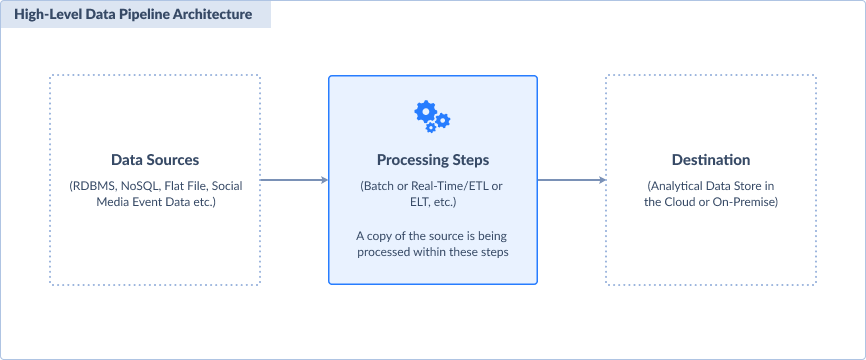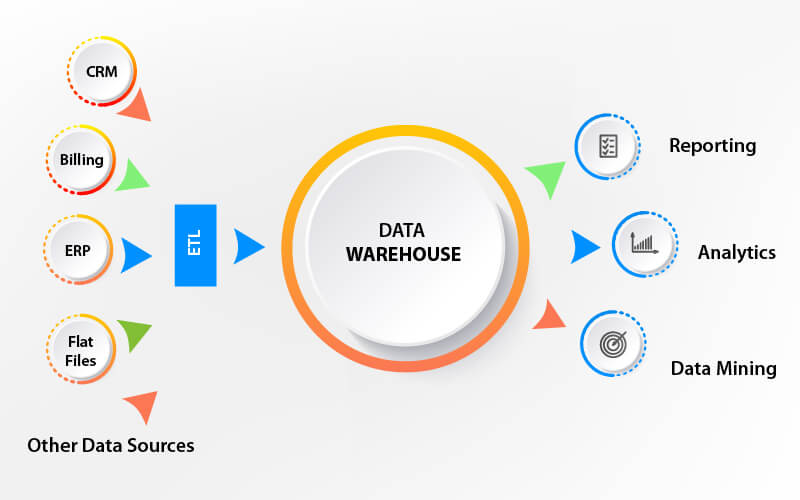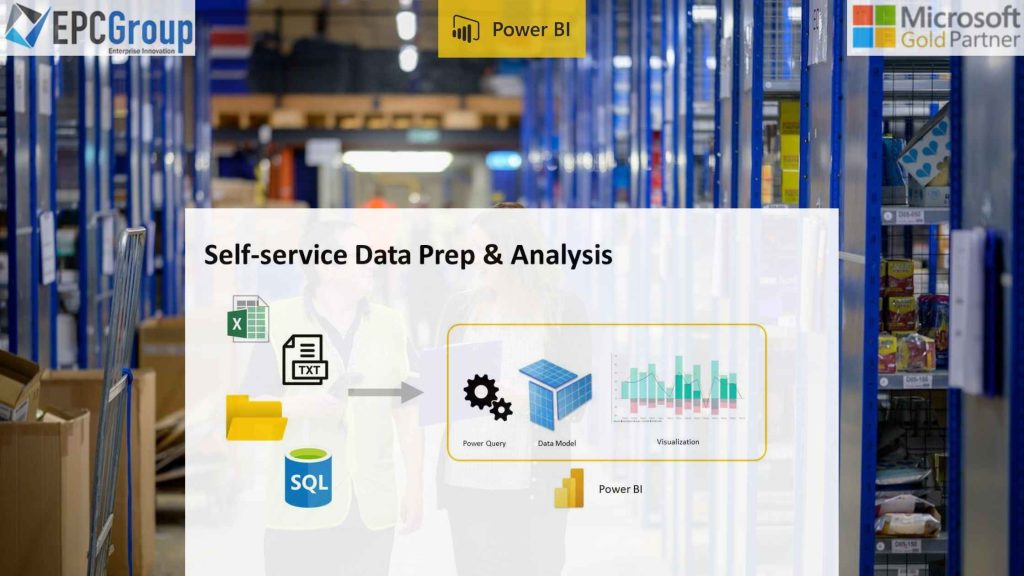A Power BI data warehouse is an enterprise-level solution that offers a complete management toolkit for managing data in excel sheets, databases, and other formats. In addition, it enables users to take advantage of the power of analytics with integrated BI tools.
The primary repository for the data in your business is a data warehouse. It’s usually housed on a high-speed server and designed to help you analyze your data in ways that make sense for the business.
The critical difference between an elemental Power BI report and a Power BI data warehouse is that the former is limited in scope. At the same time, the latter can be used to analyze large volumes of information.
A Power BI data warehouse allows you to quickly pull all your organization’s data into one place to access it from any device or location. You’ll also be able to share this data with other departments across your business — so if one department needs more information about something, they can get it without asking users at other departments for it.

What Happens to a Data Warehouse When Power BI Has ETL Capabilities?
The point of a data warehouse is to store, maintain and retrieve the data in a structured way. A data warehouse can be built using various technologies, including Hadoop and NoSQL databases.
The processes involved in building a data warehouse include the following:
- Defining the architecture
- Designing ETL jobs
- Creating the schemas and indexes
- Writing the scripts to extract the necessary data from multiple sources
- Performing data quality checks on extracted data
- Loading and processing data into RDBMS databases
The essential advantage of building a Data Warehouse (DW) compared with traditional OLTP systems is that DWs store all types of operational data irrespective of its source or format. For example, it can store transactional/transaction log data and operational reporting tables. In addition, it also provides granular access to individual rows in an efficient manner that allows fast queries across large volumes of data.
A disadvantage of DWs is that they are usually enormous and take time to build because they have complex relationships between their components, such as tables and indexes. Also, many tools are required for DW building, making them more expensive than traditional OLTP systems. However, today’s modern technologies like Power BI allow us to analyze large-volume files.

Several Benefits Of A Data Warehouse For Your Business
Among the several types of databases, data warehouses store data from many different sources and use a data warehouse architecture to store, manage, and analyze the data. Data warehouses provide a central repository for enterprise information accessible to different users and programs. They answer questions about business performance and inform decisions about where to invest resources.
There are several benefits of using a data warehouse.
- Provides insight into an organization’s operations and processes.
- It helps optimize resource allocation by providing better insights into what works best and needs improvement.
- Reduces errors in reporting and analysis. Data warehouses provide faster access to information, which reduces the time needed to process and analyze data.
- Provides more timely decision-making. A data warehouse allows you to access information quickly, making better decisions before receiving it from other sources. For example, if your company receives sales orders over the Internet, compare those orders with orders placed earlier in the day to determine whether there has been a change in customer behavior or product demand over time.
- Enables better decisions about marketing strategies. A well-designed data warehouse can be used for benchmarking against industry standards and other companies’ performance data so that your company can identify areas in which it needs improvement or where it is doing well relative to its competitors.
- A key benefit of using a data warehouse is that it combines all of your organization’s data into one location so that everyone who needs access to it can see the same information at once rather than having multiple sets of data spread across different systems or departments within an organization.

How To Use Power BI With Your Data Warehouse
Power BI allows you to quickly and easily create compelling visualizations that help drive business insights. You can also use it to quickly analyze your data and build reports, dashboards, and other interactive content.
A cloud-based corporate analytics service, Power BI, allows you to quickly and easily generate custom reports and dashboards. It combines the best of Excel with the power of R, Python, and more, to deliver a self-service analytics solution that helps you build better products faster.
The third component of our data analytics architecture is Microsoft Power BI. Because it doesn’t rely on or reveal any SQL code to fuel its queries, Power BI differs from BI products like Looker, Chartio, Periscope Data, and Mode. One may argue that business customers should find it simpler to master a visual report builder like Power BI than a query language like SQL. However, in reality, Power BI’s user interface is rather complicated, so learning it takes time, much like learning SQL. Many of the same ideas you must grasp for constructing SQL queries apply here.
Microsoft provides the cloud-based Power BI Pro tool, an on-premises Power BI Report Server, and a free Windows-only Power BI Desktop program.
The free edition of the desktop app allows you to create graphs and reports based on data stored in your organization’s databases; the Pro version includes all that, plus advanced reporting capabilities such as predictive modeling and artificial intelligence (AI). The low price point makes this tool an excellent choice for small businesses that don’t need full-blown enterprise features but want additional analysis capabilities beyond what they can get from Excel or Word documents.
Getting Started with Azure SQL Data Warehouse and Power BI
The Power BI Data Connector for Azure SQL is a RESTful API that allows you to connect your on-premises or cloud-based SQL database to Power BI. It is built using the Data Connector framework, which provides a simple, unified interface for connecting to different data sources.
If you’re trying to find a means to get started with Microsoft Azure SQL Data Warehouse, here is a great way to explore the functionality of this data platform.
Azure SQL Data Warehouse is a cloud-based data warehousing service that provides industry-leading operational performance, agility, and scale across petabyte-scale enterprise data warehouses. Leveraging the power of Azure, SQL Data Warehouse enables IT organizations to quickly and cost-effectively build and deploy enterprise-grade data warehouses.
With its intuitive user experience, SQL Data Warehouse makes it easy for anyone with no data warehouse background to build high-quality statistical models in minutes. It also provides an extensible framework of APIs so that users can extend the functionality of their solution in any way they choose.

Explaining The Differences Between A Data Warehouse, Data Mart, and Data Lake
In a data warehouse, data mart, and data lake, all phrases used to describe anything are equivalent: a repository of structured and unstructured data, generally stored in a database.
While they have many similarities, some critical differences can help you choose the right one for your organization.
Data Warehouse
A data warehouse is a structured collection of data that has been processed, cleansed, and normalized to improve its usefulness. Data warehouses are tools for storing and analyzing various data types, including tabular data, transactional data, analytical data, and historical information.
A data warehouse is often referred to as a “big data” system because it contains large volumes of heterogeneous unstructured data that are difficult to handle with traditional business intelligence techniques. As a result, organizations need to store their data systems to gain insight.
Data Mart
The data mart is a database management system that allows the collection, storage, and retrieval of structured data from multiple sources (such as databases, websites, or other systems). The term data mart has also been used to refer to data warehousing projects, where a single system collects and stores all the information about an organization’s customers.
Data marts are typically used for business intelligence. Data marts can store structured data in a database so multiple applications can access it. They can also include tools for viewing reports and mapping relationships between different sets of data.
Data Lake
Data Lakes are a new type of data storage that allows organizations to store and analyze large amounts of data in one place. Data Lakes are often built using Hadoop, but they don’t have to be. They can also be designed using other technologies, including non-Hadoop components such as databases or NoSQL stores.
In the case of an enterprise, a data lake can be used as an alternative to traditional database technology. Instead of spending money on pricey gear and software, organizations can save money by using a data lake instead.
EPC Group for Data Governance Consulting Services
EPC Group for Data Governance Consulting Services is a full-service IT consulting company. We offer comprehensive solutions to help you achieve your business goals by providing the right combination of expertise, technology, and client service.
Data governance is an essential part of many companies business objectives. Moreover, it is a critical aspect of the success of most companies, especially those that are data-driven.
The majority of data-driven enterprises are built around a framework for data governance. Data governance is necessary to guarantee that the enormous quantity of data businesses send, receive, process, analyze, and store is accurate, consistent, reliable, protected, and accessible. For business intelligence and ensuring the operational effectiveness of a data-driven firm, formal data governance is undoubtedly essential.
The EPC Group has experience crafting a robust enterprise data governance program by aligning business goals and technical precedence. We are experts in aligning our intelligent data governance policies with your company’s strategic objectives, resulting in the highest-quality actionable insights for decision-makers and stakeholders.










